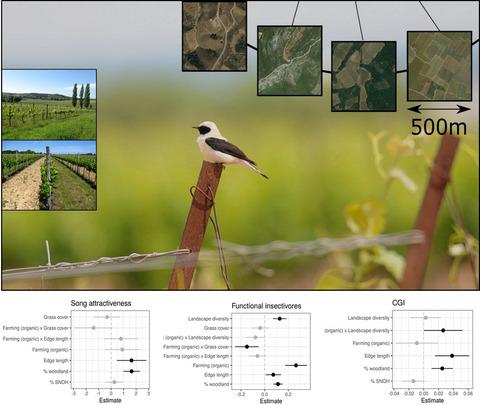当前位置:
X-MOL 学术
›
J. Appl. Ecol.
›
论文详情
Our official English website, www.x-mol.net, welcomes your
feedback! (Note: you will need to create a separate account there.)
Organic management and landscape heterogeneity combine to sustain multifunctional bird communities in European vineyards
Journal of Applied Ecology ( IF 5.0 ) Pub Date : 2021-04-18 , DOI: 10.1111/1365-2664.13885 L. Luc Barbaro 1, 2 , Giacomo Assandri 3, 4 , Mattia Brambilla 3, 5 , Bastien Castagneyrol 6 , Jérémy Froidevaux 1, 2, 7 , Brice Giffard 8 , Joséphine Pithon 9 , Xavier Puig‐Montserrat 10 , Ignasi Torre 10 , François Calatayud 1 , Pierre Gaüzère 11 , Josépha Guenser 12 , Francesc‐Xavier Macià‐Valverde 10 , Séverine Mary 12 , Laurent Raison 1 , Clélia Sirami 1 , Adrien Rusch 8
中文翻译:

有机管理和景观异质性相结合,以维持欧洲葡萄园的多功能鸟类群落
更新日期:2021-06-02
Journal of Applied Ecology ( IF 5.0 ) Pub Date : 2021-04-18 , DOI: 10.1111/1365-2664.13885 L. Luc Barbaro 1, 2 , Giacomo Assandri 3, 4 , Mattia Brambilla 3, 5 , Bastien Castagneyrol 6 , Jérémy Froidevaux 1, 2, 7 , Brice Giffard 8 , Joséphine Pithon 9 , Xavier Puig‐Montserrat 10 , Ignasi Torre 10 , François Calatayud 1 , Pierre Gaüzère 11 , Josépha Guenser 12 , Francesc‐Xavier Macià‐Valverde 10 , Séverine Mary 12 , Laurent Raison 1 , Clélia Sirami 1 , Adrien Rusch 8
Affiliation

|
- Conserving functionally diverse bird communities in European farmland is becoming critical, with no exception for regions of wine production. Management intensification combined with the loss of semi-natural habitats in wine-growing landscapes has led to a long-term decline not only in birds of conservation concern but also in once common insectivores and seed eaters. These declines are expected not only to threaten key ecological services provided by vineyard birds, such as pest or weed control, but also their cultural significance.
- We analysed how organic management and landscape heterogeneity affected taxonomic and functional diversity of 334 bird communities from 12 regions of the three main wine-producing European countries (France, Italy and Spain). We further modelled the responses of community-level metrics measuring mean habitat specialization and bird song attractiveness to humans, as well as cumulative abundances of functional insectivores, seed and grape eaters to account for individual avian functions.
- We found that organic viticulture enhanced bird functional diversity and individual functions, but that its positive effect partially depended on grass cover management in the inter-rows and landscape heterogeneity. Woodland cover and landscape compositional heterogeneity increased both taxonomic and functional diversity of bird communities, as well as functional insectivory. Landscape configurational heterogeneity also increased functional diversity and mean song attractiveness of bird communities.
- Overall, both bird diversity and functions were enhanced by higher landscape heterogeneity, especially in organic vineyards. However, mean habitat specialization decreased with woodland cover and configurational heterogeneity, meaning that open habitat specialists preferred more even landscapes with high vineyard cover.
- Synthesis and applications. Our study highlights the benefits of combining organic management and partial grass cover at the field level and promoting interfaces between vineyards and semi-natural habitats at the landscape level to sustain multifunctional bird communities in wine-producing European countries.
中文翻译:

有机管理和景观异质性相结合,以维持欧洲葡萄园的多功能鸟类群落
- 保护欧洲农田中功能多样的鸟类群落变得至关重要,葡萄酒生产地区也不例外。管理的集约化加上葡萄种植景观中半自然栖息地的丧失,不仅导致了受保护鸟类的长期下降,而且曾经常见的食虫动物和种子食者的数量也出现了长期下降。预计这些下降不仅会威胁到葡萄园鸟类提供的关键生态服务,例如害虫或杂草控制,还会威胁到它们的文化意义。
- 我们分析了有机管理和景观异质性如何影响来自三个主要葡萄酒生产欧洲国家(法国、意大利和西班牙)的 12 个地区的 334 个鸟类群落的分类和功能多样性。我们进一步模拟了衡量平均栖息地专业化和鸟鸣对人类的吸引力的社区级指标的反应,以及功能性食虫动物、种子和葡萄食者的累积丰度,以解释个体鸟类的功能。
- 我们发现有机葡萄栽培增强了鸟类功能多样性和个体功能,但其积极影响部分取决于行间草覆盖管理和景观异质性。林地覆盖和景观成分异质性增加了鸟类群落的分类和功能多样性,以及功能性食虫。景观构型异质性也增加了鸟类群落的功能多样性和平均歌曲吸引力。
- 总体而言,更高的景观异质性增强了鸟类的多样性和功能,尤其是在有机葡萄园中。然而,平均栖息地专业化随着林地覆盖和构型异质性而降低,这意味着开放栖息地专家更喜欢葡萄园覆盖率高的平坦景观。
- 合成与应用。我们的研究强调了在田间水平上将有机管理和部分草地覆盖相结合的好处,并在景观水平上促进葡萄园和半自然栖息地之间的接口,以维持欧洲葡萄酒产区的多功能鸟类群落。











































 京公网安备 11010802027423号
京公网安备 11010802027423号